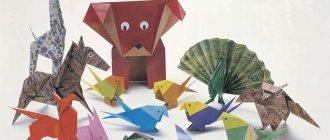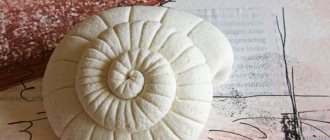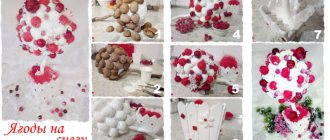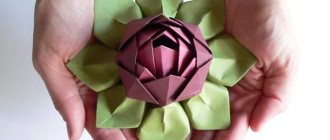Paper rocket for kids
Roll a cylinder from a rectangle, and a cone for the top from a semicircle. Separately glue the portholes and side supports in the form of small cones. If you want the rocket to be a little more stable, use thicker paper or thin cardboard for the base. This is an ideal craft for kindergarten: extremely easy, understandable and bright.
Photo: paper-land.ru
Features of work organization
The complexity of the craft is determined based on the child’s age, level of development, and interests. There is no point in forcing a child to make model rockets out of paper if he is interested in something completely different. Bright photos of rocket crafts can attract his attention and interest.
In the youngest age group, children make flat models. At the initial stage, coloring books are available for them: outline images on paper. The child learns to hold a colored pencil, carefully paints certain areas without going beyond their boundaries, and monitors the uniformity of paint application.
It is convenient to paint the outline of the rocket with a brush using watercolor and gouache paints. With any method of performing work, pay attention to the consistency and accuracy of execution.
Unobtrusively, but steadily, with encouragement and attention, and not with criticism and indifference, the child is taught that his little work should look attractive and be liked by other children and adults.
Perhaps the first craft will not turn out the way you would like. In this case, you should invite the child to color not just one rocket, but several, a whole series.
Surely the second, third, and subsequent works will be much better. It is at this moment that adult support is important to consolidate the situation of success and develop a sense of confidence.
Children's attention and interests are unstable; kids can easily become interested in building a rocket and even more easily move on to something else. To develop a more permanent hobby, you should adhere to the principle of systematicity.
To do this, work on making rockets for children is carried out day after day at a certain time. Within a week, the child will be looking forward to the hour when he can start designing.
A simple rocket for beginners
This is a very simple origami pattern that even small children can handle in a few steps. The rocket folds up like a house, only then you need to bend the sides to the other side with steps. The finished craft is suitable for appliques, decorating cards or creating holiday packaging.
Photo: handmade.jofo.me
Rescue system
The rescue system is one of the most complex in a rocket. It includes a parachute, attachment to the body, and a parachute release mechanism. It must be checked more than once on the ground. I use a pyrotechnic version of a parachute release (mortar), initiated by the on-board computer. Although there are other solutions - mechanical and pneumatic, or even inertial. The pyrotechnic system is one of the most popular and simplest, containing a minimum of components.
Blank for mortar
The parachute itself is a canopy with a diameter of 70 centimeters, sewn from durable and lightweight fabric (rip-stop). You can calculate exactly the required parachute area for a smooth descent depending on the mass of the rocket. Although, from practice, it is better to make the parachute smaller in diameter - this will increase the speed of the rocket’s fall, of course, but the rocket will be less blown away by the wind, and therefore there is less chance of covering kilometers from the launch site to the crash site.
Cutting out the parachute
It is equally important to ensure that the rocket recovery system is attached to the body. Typically, power bolts are installed in the body, to which a power cable (halyard) is attached, connecting to the parachute lines. The halyard is passed through a wad - a light cylinder, which is installed flush against the internal diameter of the rocket - it is necessary for releasing the parachute, working like a piston driven by gases from the mortar.
Rescue system fastening design
The head fairing is also tied to the halyard.
When assembled, the rocket's internal components occupy the entire internal volume.
Model rocket with all components
Simple rocket with notches
This scheme is very similar to the previous one, but at the same time a little different. Thanks to small cuts at the bottom, the side supports are more expressive and realistic. This diagram looks good even from one-sided colored paper, and add portholes and other little things on top.
Photo: infourok.ru
Crochet napkins: 6 simple patterns for beginners
Spaceship
If your young astronaut already has a helmet, it is quite expected that he will start dreaming of a real spaceship. Well, everything is doable. Such a large-scale craft will have to be done by all family members: adults assemble and connect parts of the ship, children take part in developing the layout and decor. What's not a reason to spend the evening together, without gadgets? In addition, a rocket or spaceship will be an excellent playground for children to play.
You will need:
- various large boxes;
- scissors and cutter;
- large size cardboard, for example A2;
- paints or colored paper;
- foil;
- hot glue, tape.
Progress:
- Assemble the future shuttle, secure the boxes together with glue.
- Cut through portholes, make an entrance.
- Cut out supports from cardboard and secure them into the slots on the sides of the spacecraft.
- Glue the top together from cardboard or a box.
- Paint the parts or cover them with wallpaper/paper.
- Decorate with decor: stick on stars, sparkles. You can add a battery-powered garland, securing it with tape.
Tip: Use foil to imitate a metallic sheen.
Send well-prepared young researchers into space: provide children with juice in boxes and purees in soft patches, like real astronauts.
Crafts based on one of children’s favorite themes for games can be made not only for Cosmonautics Day, but throughout the year. This is a great way to spend time with the whole family in the evening or on a weekend. Space crafts can spark a lot of interest in the topic among your children. And who knows, maybe a real future cosmonaut is growing up here!
Origami rocket with colored fire
This origami rocket looks interesting from one-sided colored paper, and it is the fire that remains bright, and the frame itself is white. Place the rectangle with the white side up, bend the part back to a square. Shape the corners and sides to create a kind of house. Turn the workpiece over, form the side walls with a ladder, turn it around again and spread the colored fire down.
Photo: podelunchik.ru
Origami paper rocket
This diagram is similar to the previous one and starts in the same way with a standard origami triangle. Fold the sides towards the middle and arrange each corner into a thin diamond shape on all four sides separately. Wrap the side supports with a ladder, hide the fold under the base of the rocket and form a curly transition.
Photo: zuowen2.info
Amigurumi for beginners: 6 simple patterns step by step
Wide origami rocket
Another similar scheme from the basic triangle differs from the previous ones in that the finished rocket is much wider. Fold the bottom corners up, lay each of them into a square, bend it in half and lay it out again. Tuck the central part and unfold it into another similar, already third, house.
Photo: rci76.ru
Rocket made from cardboard tubes
If you want to assemble a larger and stronger model, take a sheet of cardboard and cylindrical bushings. A base made from any rolled paper or paper towels will do. Cut out the main parts and make side cuts to connect them, like a simple 3D puzzle. Before assembly, paint and decorate the rocket with gouache and PVA or acrylic paints.
Photo: pinkstripeysocks.com
Paper origami for beginners: 10 easy patterns
Space crafts for school
When we hear about space-themed crafts, rockets, airplanes and stars immediately come to mind. We invite you to bring more original ideas to life.
UFO
Even though building a UFO seems like a very difficult task, we offer a simple and easy way. Such a craft will surprise school teachers and will definitely not go unnoticed at an exhibition of creative works.
You will need:
- 2 plastic bottles blue or green;
- 2 disposable plates;
- scissors;
- Styrofoam;
- hot glue;
- skewers;
- large beads;
- white cocktail tube;
- battery-powered garland (preferably with white light).
Progress:
- Trim the bottom of the bottles.
- In one of the plastic plates, cut a large circle in the center, slightly smaller than the diameter of the cut bottom of the bottle. Cut out a small circle in another plate.
- It is advisable to heat the edges of the cut bottom of a plastic bottle with an iron to even out the edges. This way the part will stick better to the craft.
- Apply glue to the edges of the cut bottom of the bottle and glue it to the plate where you cut out a large circle.
- Cut the foam into thin squares.
- Cut a strip from the remains of a plastic bottle and straighten it as much as possible.
- Glue the foam squares with a small distance from each other along the entire length of the strip.
- On a plate where a small circle is cut out, carefully poke 3 holes around it with scissors.
- Insert skewers into these holes, securing them with glue and beads. The skewers need to be attached not evenly, but so that they look slightly to the sides. These will be the legs of our UFO.
- Cut the white cocktail tube into 3 equal parts. Place each one on the “leg” of the UFO. If you don’t have a tube of the desired color on hand, you can paint the legs with white paint.
- Grease the tips of the legs with glue and put beads on them.
- Glue one of the strips of foam plastic along the diameter to the plate on which the legs were made.
- Place the garland inside, leaving the “tail” with batteries outside. Glue the top part - a plate with a bottle bottom.
The craft is ready. All that remains is to turn on the lights and go on a space adventure.
Saturn
To create a real planet with your own hands, you will need available tools. It should be noted that the craft will take a lot of time: in total, it will take about 2 days for the model of the planet to dry. Therefore, you need to take care of its production in advance.
You will need:
- PVA glue;
- brush;
- balloon;
- paper towel or white napkins;
- cardboard;
- paints.
Progress:
- Inflate the balloon.
- Using PVA glue, cover it with napkins, leaving a small space free at the “tail” (in order to later remove the ball from it).
- Let dry (about a day). Carefully burst the ball and remove it through the remaining hole.
- Cover the resulting void with paper. Let dry thoroughly (also about a day).
- Color the ball in the appropriate colors (yellow and orange shades). Leave to dry for 10-15 minutes.
- Make a ring out of cardboard (use a compass to measure the exact diameter).
- Attach the ring to the planet and color it.










